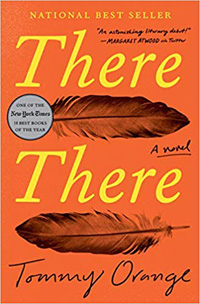 Tommy Orange, There There: A Novel (New York: Knopf, 2018), 294pp.
Tommy Orange, There There: A Novel (New York: Knopf, 2018), 294pp.
What does it mean to be a Native American today, after four hundred years of depopulation, mass murder, forced assimilation, numerous betrayals, altered histories, and violent stereotypes? More particularly, what does it mean to be an Urban Indian in a place like Oakland, where author Tommy Orange was born and raised, and which is the setting for his novel? And what does it mean if, like Orange, one of your parents is white, but you are nonetheless an enrolled member of the Cheyenne and Arapaho Tribes of Oklahoma? What is "Indianness" (p. 232)?
These questions about identity require what Orange calls a "polyphonic" approach of many different voices. His debut novel, which was a blockbuster success in the summer of 2018, revolves around the stories of a dozen characters whose lives converge in the final pages at the Big Oakland Powwow. Perhaps there are glimmers of hope, of recovered histories, and a new sense of genuine agency, but most of the stories of these dozen protagonists are profoundly sad.
Tony Loneman has Fetal Alcohol Syndrome. His mother is in jail, his father is out of state in New Mexico, and he's been suspended from school numerous times for fighting. Dene Oxendene has applied for a cultural arts grant to collect the stories of urban Indians, but he's worried how the panel of judges will view him: "They'll think he's white — which is only half true — and so ineligible. Dene is not recognizably Native. He is ambiguously nonwhite. Over the years he'd been assumed Mexican plenty, been asked if he was Chinese, Korean, Japanese, Salvadoran once, but mostly the question came like this: What are you?"
Opal Viola Victoria Bear Shield asks her mother, a victim of domestic violence, "why do we got names like we do?" Her mother explains how "the white people" renamed Native Americans, and how "you gotta know about the history of your people." Jacquie Red Feather laments the "staggering" number of suicides in Native communities. Edwin Black is a thirty-year-old man-boy who struggles with internet addiction (he has 660 Native friends on Facebook) and obesity.
"We are Indians and Native Americans," writes Orange. "American Indians and Native American Indians, North American Indians, Natives, NDNs, and Ind'ins, Status Indians and Non-Status Indians, First Nations Indians and Indians so Indian we either think about the fact of it every single day or we never think about it at all. We are Urban Indians and Indigenous Indians, Rez Indians and Indians from Mexico and Central and South America. We are Alaska Native Indians, Native Hawaiians, and European expatriate Indians, Indians from eight different tribes with quarter-blood quantum requirements and so not federally recognized Indian kinds of Indians. We are enrolled members of tribes and disenrolled members, ineligible members and tribal council members. We are full-blood, half-breed, quadroon, eighths, sixteenths, thirty-seconds. Undoable math. Insignificant remainders." In short, Indians trying to forge authentic identities in the dark shadows of a horrific history.


